Janome MC 200E User Manual
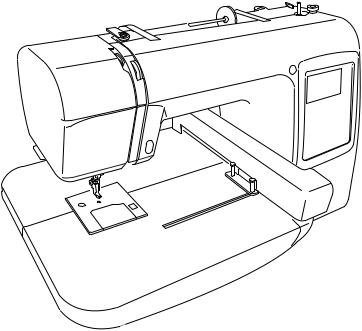
INSTRUCTION BOOK
MC 200E

IMPORTANT SAFETY INSTRUCTIONS
This sewing machine is not a toy. Do not allow children to play with this machine.
The machine is not intended for use by children or mentally infirm persons without supervision. This sewing machine is designed and manufactured for household use only.
Read all instruction before using this sewing machine.
DANGER – To reduce the risk of electric shock:
1.An appliance should never be left unattended when plugged in. Always unplug this sewing machine from the electric outlet immediately after using and before cleaning.
2.Do not reach for the appliance that has fallen into water. Unplug immediately.
3.Do not place or store appliance where it can fall or be pulled into a tub or sink. Do not place in or drop into water or other liquid.
WARNING – To reduce the risk of burns, fire, electric shock, or injury to persons:
1.Do not allow children to play with the machine. The machine is not intended for use by children or infirm persons without proper supervision.
Do not allow to be used as a toy. Close attention is necessary when this sewing machine is used by or near children.
2.Use this appliance only for its intended use as described in this owner’s manual.
Use only attachments recommended by the manufacturer as contained in this owner’s manual.
3.Never operate this sewing machine if it has a damaged cord or plug, if it is not working properly, if it has been dropped or damaged, or dropped into water.
4.Never operate the appliance with any air opening blocked. Keep ventilation opening of this sewing machine and foot controller free from accumulation of lint, dust and loosen cloth.
5.Never drop or insert any object into any opening.
6.Do not use outdoors.
7.Do not operate where aerosol (spray) products are being used or where oxygen is being administered.
8.To disconnect, turn all controls to the off (“O”) position, then remove plug from outlet.
9.Do not unplug by pulling on cord. To unplug, grasp the plug, not the cord.
10.Keep fingers away from all moving parts. Special care is required around the sewing machine needle.
11.Always use the proper needle plate. The wrong plate can cause the needle to break.
12.Do not use bent needles.
13.Do not pull or push fabric while stitching. It may deflect the needle causing it to break.
14.Switch this sewing machine off (“O”) when making any adjustment in the needle area, such as threading the needle, changing the needle, threading the bobbin or changing the presser foot, and the like.
15.Always unplug this sewing machine from the electrical outlet when removing covers, lubricating, or when making any other adjustments mentioned in this owner’s manual.
SAVE THESE INSTRUCTIONS
The design and specifications are subject to change without a prior notice.
Please note that on disposal, this product must be safely recycled in accordance with relevant National legislation relating to electrical/electronic products. If in doubt please contact your retailer for guidance. (European Union only.)
Table of contents
Name of parts .............................................................. |
2 |
Standard accessories .................................................. |
3 |
GETTING READY TO SEW |
|
Connecting the power supply ....................................... |
4 |
For your safety ............................................................. |
4 |
Polarized plug............................................................... |
4 |
Start/stop button ........................................................... |
5 |
Presser foot lifter .......................................................... |
5 |
Winding the bobbin ...................................................... |
6 |
Removing the bobbin ............................................... |
6 |
Setting the spool of thread ....................................... |
6 |
Additional spool pin.................................................. |
6 |
Winding the bobbin .................................................. |
7 |
Inserting the bobbin ................................................. |
8 |
Threading the machine ................................................ |
9 |
Needle threader ......................................................... |
10 |
Drawing up the bobbin thread .................................... |
11 |
Changing the needle .................................................. |
12 |
Adjusting the thread tension....................................... |
13 |
Balanced thread tension ........................................ |
13 |
When the needle thread tension is too tight .......... |
13 |
When the needle thread tension is too loose......... |
13 |
Adhesive (iron-on) stabilizer ....................................... |
14 |
Stabilizers................................................................... |
14 |
Types of stabilizer .................................................. |
14 |
Usage .................................................................... |
14 |
Template..................................................................... |
14 |
KEY OPERATIONS ............................................... |
15-21 |
Adjusting the brightness of LCD screen ..................... |
15 |
Function panel....................................................... |
15-16 |
Setting mode .............................................................. |
17 |
Machine settings ................................................... |
17-20 |
HELP key ................................................................... |
21 |
Setting the fabric in the embroidery hoop .................. |
22 |
Attaching the embroidery hoop to the machine ......... |
23 |
Selecting built-in designs ........................................... |
24 |
Ready to sew screen .................................................. |
24 |
Color list screen ......................................................... |
24 |
Starting to sew embroidery ................................... |
25-26 |
When the upper thread has broken or run out while |
|
sewing .................................................................... |
26 |
Lettering embroidery ............................................. |
27-30 |
Selecting fonts ....................................................... |
27 |
Entering characters................................................ |
27 |
To enter lettering .................................................... |
28 |
Ready to sew screen ............................................. |
29 |
Color change ......................................................... |
29 |
Placement of lettering embroidery ......................... |
29 |
Maximum number of characters ............................ |
29 |
To view a long lettering .......................................... |
30 |
Deleting a letter ...................................................... |
30 |
Inserting a letter ..................................................... |
30 |
Editing mode ........................................................ |
3138 |
Selecting the hoop ................................................. |
31 |
Selecting the pattern to edit ................................... |
32 |
Magnifier key.......................................................... |
33 |
Flipping the pattern ................................................ |
33 |
Resizing the pattern ............................................... |
34 |
Rotating the pattern ............................................... |
34 |
Combining patterns........................................... |
35-38 |
Saving the file ............................................................. |
39 |
Saving in internal memory ......................................... |
39 |
Name of file ........................................................... |
39-40 |
Saving in USB memory (optional) .............................. |
41 |
Creating a new folder ................................................. |
42 |
Opening a file from the internal memory .................... |
43 |
Deleting a file ............................................................. |
43 |
Opening a file from USB memory (optional) .............. |
44 |
CARE AND MAINTENANCE ..................................... |
45 |
Cleaning the hook race .............................................. |
45 |
Assembling the hook race .......................................... |
45 |
TROUBLESHOOTING .......................................... |
46-47 |
DESIGN CHARTS ................................................. |
48-50 |
1
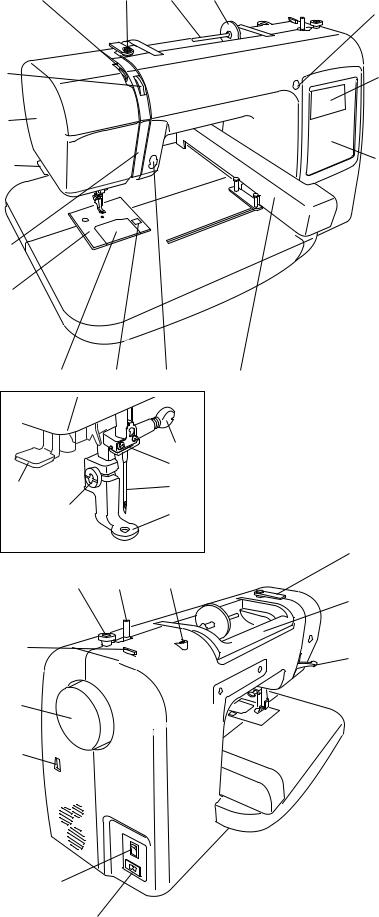
7 |
6 |
5 |
4 |
8
9
10
11
12
13 |
14 |
15 |
16 |
|
17 |
|
18 |
22 |
19 |
21 |
20 |
25 24 23
26
27
28
29
30
3
2
1
33
32
31
Name of parts
1Function panel
2LCD screen
3LCD brightness adjusting dial
4Spool holder (large)
5Spool pin
6Bobbin thread guide
7Thread take-up lever
8Thread tension dial
9Face plate
10Thread cutter & thread holder
11Thread guide plate
12Needle plate
13Hook cover plate
14Hook cover plate release button
15Start/stop button
16Carriage
17Needle clamp screw
18Needle bar thread guide
19Needle
20Presser foot
21Setscrew
22Needle threader
23Hole for additional spool pin
24Bobbin winder spindle
25Bobbin winder stopper
26Thread cutter
27Handwheel
28USB socket
29Power switch
30Machine socket
31Presser foot lifter
32Carrying handle
33Thread guide cover
2
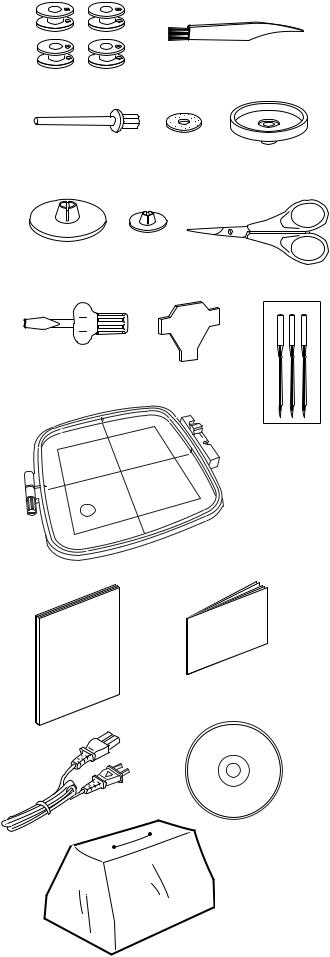
1 |
2 |
3 |
4 |
5 |
|
|
|
|
|
|
|
|
|
|
|
|
|
6 |
7 |
8 |
9 |
10 |
11 |
12
13 |
14 |
15 |
16 |
|
17
Standard Accessories
1Bobbin
2Lint brush
3Additional spool pin
4Felt
5Spool stand
6Spool holder (Large)
7Spool holder (Small)
8Scissors
9Screwdriver
10Screwdriver
11Set of needles
12Embroidery hoop
13Instruction book
14Template sheets
15Power supply cord
16Instructional movie CD
17Soft cover
3

GETTING READY TO SEW
Connecting the power supply
Turn off the power switch and insert the machine plug into the machine socket.
Insert the power supply plug into the wall outlet and turn the power switch on.
q Power switch w Machine plug e Machine socket
|
q |
|
r Power supply plug |
|
|
|
|
|
|
|
t Wall outlet |
|
|
|
NOTE: |
|
|
|
After turning on the power, it takes approximately ten |
|
|
|
seconds for boot-up. |
|
w |
|
t |
|
|
For Your Safety |
|
|
|
|
|
e |
|
|
While in operation, always keep your eyes on the sewing |
|
|
|
area, and do not touch any moving parts such as the |
|
|
|
thread take-up lever, handwheel or needle. |
|
|
|
Always turn off the power switch and unplug the power |
|
|
|
supply: |
|
|
r |
- when leaving the machine unattended. |
|
|
- when attaching or removing parts. |
|
|
|
|
|
|
|
|
- when cleaning the machine. |
Polarized plug (for U.S.A and Canada only)
The symbol “O” of a switch indicates the “off” position of a switch.
For appliances with a polarized plug (one blade wider than the other). To reduce the risk of electric shock, this plug is intended to fit in a polarized outlet only one way. If it does not fit fully in the outlet, reverse the plug. If it still does not fit, contact a qualified electrician to install the proper outlet. Do not modify the plug in any way.
4

q
 Lower the
Lower the
Presser Foot.
w
Start/stop button
Press this button to start or to stop the machine. q Start/stop button
NOTE:
If you press the start/stop button without lowering the presser foot, a warning message appears on the LCD screen.
Lower the presser foot and press the OK key to return to the previous display.
w OK key
Presser foot lifter q Presser foot lifter
The presser foot lifter raises and lowers the presser foot. You can raise it higher than the normal up position for easy removal of the presser foot or to set the embroidery hoop.
q
5

q |
Winding the bobbin |
Removing the bobbin |
|
z |
z Slide the hook cover plate release button to the right, |
|
|
|
and remove the hook cover plate. |
w
x |
x Lift out the bobbin from the bobbin holder. |
q Hook cover plate release button w Hook cover plate
e Bobbin
|
e |
|
Setting the spool of thread |
z |
z Place the spool of thread on the spool pin with the |
|
thread coming off the spool as shown. Attach the large |
|
spool holder, and press it firmly against the spool of |
|
thread. |
|
q Large spool holder |
|
q |
x |
x Use the small spool holder to hold narrow or small |
|
spools of thread. |
|
w Small spool holder |
|
w |
|
Additional spool pin |
|
|
Use the additional spool pin when you need to wind the |
|
r |
bobbin without unthreading the machine while working |
|
on an embroidery. |
||
q |
Insert the additional spool pin into the spool stand and |
|
then into the hole beside the horizontal spool pin. |
||
|
Place the felt on the spool pin and place a spool of |
|
w |
thread on it as shown. |
|
|
q Additional spool pin |
|
|
w Spool stand |
|
e |
e Hole |
|
r Felt |
||
|
6
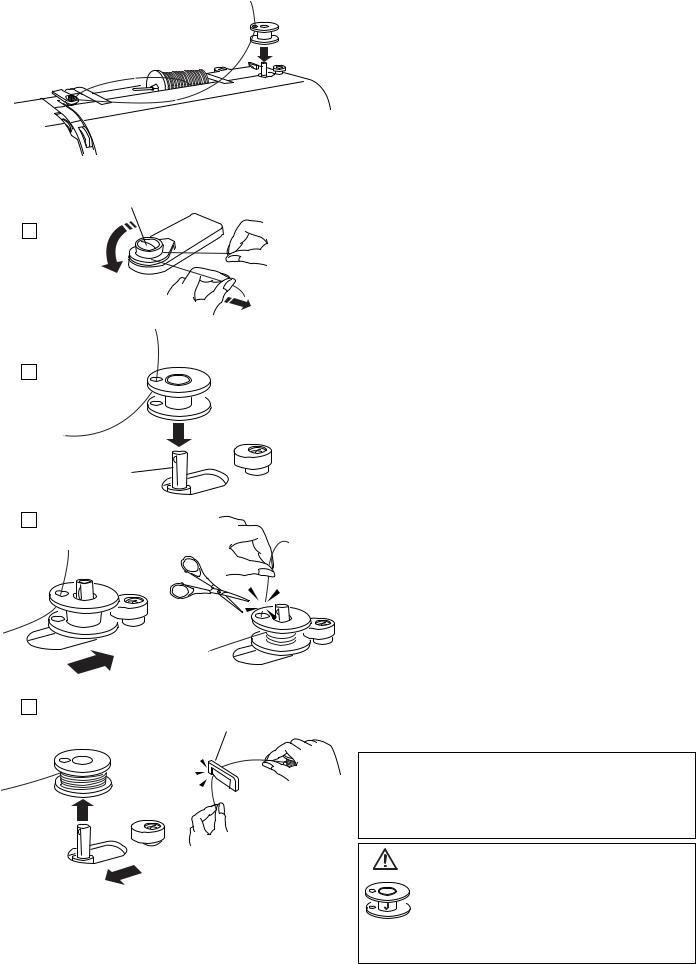
Winding the bobbin
1
2
q
z Guide the thread around the bobbin winder thread guide while holding the thread with both hands. q Bobbin winder thread guide
x Thread through the hole in the bobbin from the inside to the outside. Put the bobbin on the bobbin winder spindle.
w Bobbin winder spindle
w
3
4
cPush the spindle to the right. Press the start/stop button while holding the end of the thread. Stop the machine after the bobbin is wound a few layers.
Cut the thread close to the hole in the bobbin.
|
v Press the start/stop button again. When the bobbin is |
|
|
fully wound it will stop automatically. |
|
|
Press the start/stop button to stop the machine |
|
|
then return the bobbin winder spindle to the left. |
|
|
Remove the bobbin and cut the thread with the |
|
e |
bobbin thread cutter. |
|
e Bobbin thread cutter |
||
|
NOTE:
Do not move the bobbin winder spindle while the machine is running.
For safety purposes, the motor will stop automatically after running for two minutes.
CAUTION
Use the Janome plastic bobbin for horizontal hook machines (marked with J). Using other bobbins, such as prewound paper bobbins, may cause stitching problems or damage the bobbin case.
7
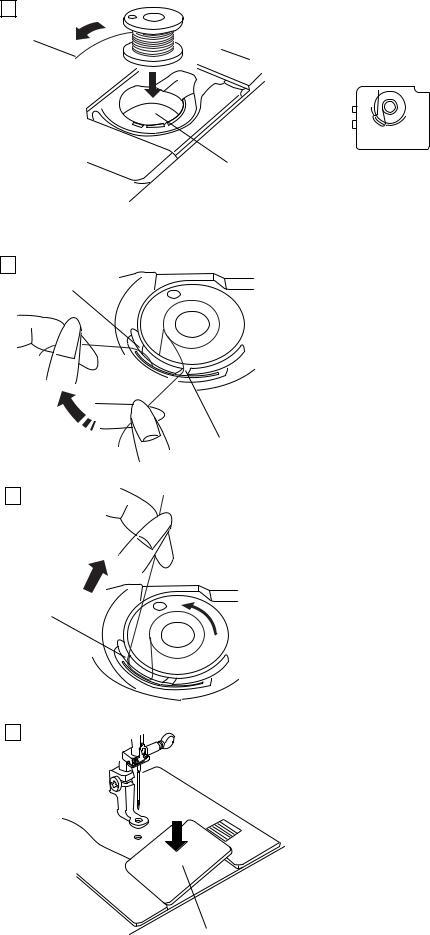
Inserting the bobbin
1
q
zPlace the bobbin in the bobbin holder with the thread running off in a counterclockwise direction.
q Thread
wBobbin holder
*Refer to the threading chart shown on the hook cover plate.
w
2 |
x Guide the thread into the notch on the front of |
|
r |
||
the bobbin holder. |
||
|
Draw the thread to the left, sliding it between the |
|
|
tension spring blades. |
|
|
e Front notch |
e
3
c Continue to draw the thread lightly until the thread slips into the side notch.
Pull out about 10 cm (4˝) of thread to the rear. r Side notch
r
4 |
v Reattach the hook cover plate. |
|
t Hook cover plate
t
8

Threading the machine
1
3
4 |
|
2 |
5 |
|
|
1 |
q |
z Raise the presser foot lifter. Turn the handwheel |
|
||
|
|
to bring the needle to its highest position. Draw |
|
|
the thread around and under the thread guide |
|
|
while holding the thread at the spool. Then draw the |
|
|
thread down through the right channel of the thread |
|
|
tension dial. |
|
|
q Thread guide |
2 |
|
x Firmly draw the thread around the thread guide |
|
|
plate and up to the thread take-up lever. |
|
|
w Thread guide plate |
|
|
w |
|
3 |
e |
|
c Slip the thread through the slit and down into the |
|
|
eye of the take-up lever as shown. Draw the |
|
|
|
|
|
|
|
r |
thread down through the left channel. |
|
|
e Slit |
|
|
|
|
|
|
|
|
r Eye of the take-up lever |
4 |
5 |
|
v Slip the thread behind the lower thread guide |
|
from the right. |
||
|
|
|
|
|
|
|
b Slip the thread in the needle bar thread guide |
|
|
|
from the left. |
|
|
|
t Needle bar thread guide |
|
|
|
Thread the needle from front to back by hand or use the |
|
|
t |
built-in needle threader. |
|
|
|
|
|
|
|
NOTE: |
|
|
|
Refer to page 10 for built-in needle threader. |
9
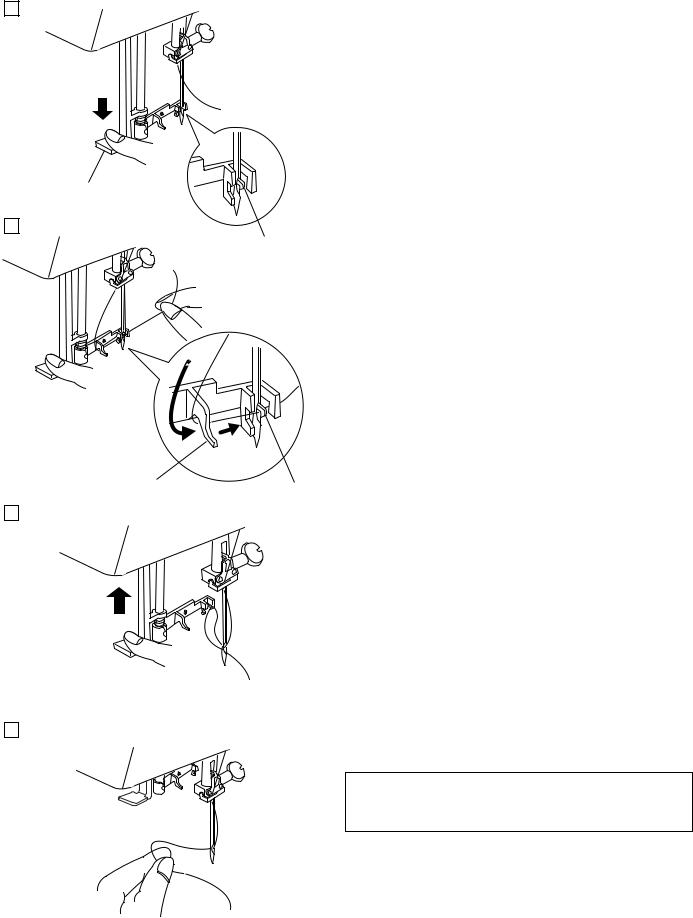
Needle threader
1
q
zLower the presser foot. Depress the needle threader knob as far as it will go. The hook comes out through the needle eye from behind.
q Needle threader knob w Hook
2 |
|
x Draw the thread down around the threader guide |
|
w |
|
|
and under the hook. |
|
|
|
|
|
|
e Threader guide |
e |
w |
|
3
4
cRelease the threader knob slowly while holding the thread end with your hand. A loop of the thread is pulled up through the needle eye.
vRemove the loop from the threader and pull out the thread end from the needle eye.
NOTE:
The needle threader works well with the threads #50-90 and needles #11-14, as well as the blue tip needles.
10
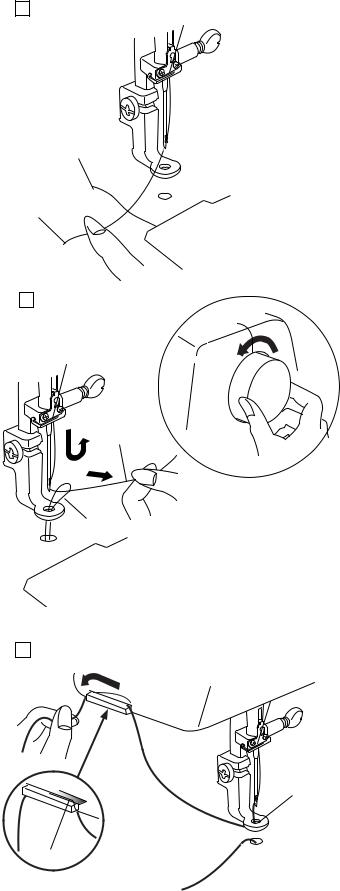
1
w
q
2
q
w
3
Drawing up the bobbin thread
zRaise the presser foot lifter. Hold the needle thread with your finger.
q Needle thread w Bobbin thread
xTurn the handwheel one complete turn towards you. Draw the needle thread to bring up a loop of the
bobbin thread.
cPass the needle thread through the hole in the embroidery foot and draw it up to the thread holder leaving an inch of free thread.
e Hole
r Thread holder
e
r
11
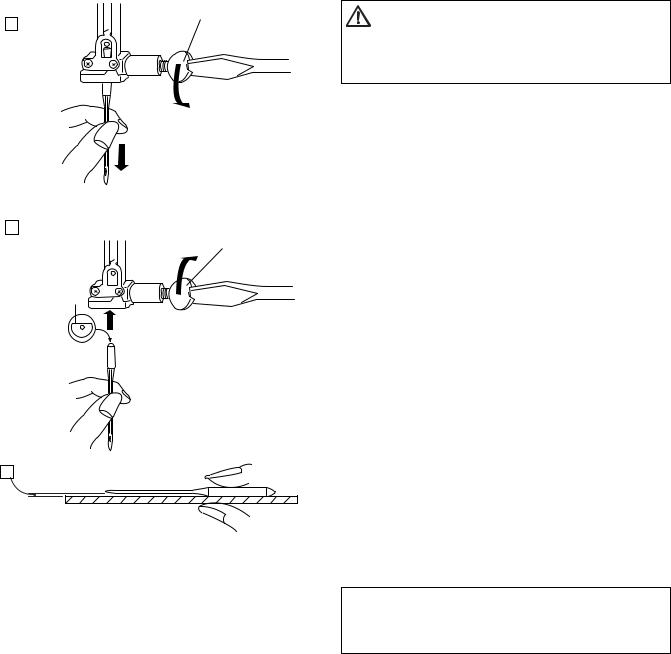
|
|
Changing the needle |
1 |
q |
CAUTION |
|
||
|
|
Always make sure to turn the power switch off and |
|
|
disconnect the machine from the power supply before |
|
|
changing the needle. |
|
|
z Turn off the power switch. Raise the needle by |
|
|
turning the handwheel and lower the presser foot. |
|
|
Loosen the needle clamp screw by turning it |
|
|
counterclockwise. |
|
|
Remove the needle from the clamp. |
2 |
|
x Insert a new needle into the needle clamp with the flat |
|
side of the needle to the rear. |
|
|
q |
|
|
|
q Needle clamp screw |
|
|
w Flat side of the needle |
|
w |
When inserting the needle into the needle clamp, push it |
|
|
|
|
|
up as far as it will go and tighten the needle clamp screw |
|
|
firmly. |
3 |
To check needle straightness, place the flat side of the |
|
needle onto something flat (a needle plate, glass etc.) |
||
|
||
|
The gap between the needle and the flat surface should |
|
|
be consistent. |
|
|
e Gap |
Never use a blunt needle.
NOTE:
Use size 11 blue tipped needles for fine fabrics. For medium to heavy weight fabrics, use size 14 needles.
12
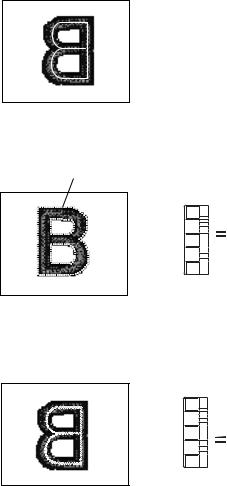
q
5 





 4
4 

3 

5 




 4
4 

3 


Adjusting the thread tension
Balanced thread tension
A small amount of needle thread shows on the wrong side of the fabric.
When the needle thread tension is too tight
The bobbin thread shows on the right side of the fabric. Reduce the tension by turning the tension dial to a lower number.
q Bobbin thread
When the needle thread tension is too loose
The needle thread forms loops and the stitches look shaggy.
Increase the tension by turning the dial to a higher number.
13
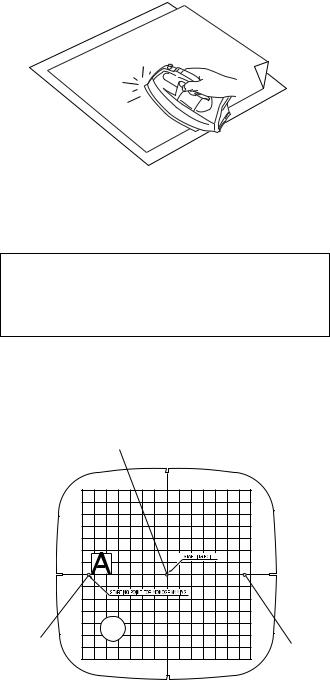
Adhesive (Iron-on) stabilizer
Place the wrong side of fabric and the glossy side of the stabilizer together. Fold up a corner of the stabilizer and fuse it with an iron.
NOTES:
Fold up a corner of the stabilizer, to make it easier to peel off the excess stabilizer after stitching.
Ironing temperatures vary depending on the type of adhesive type stabilizer being used.
Stabilizers
To obtain the best quality embroidery, it is important to use stabilizers.
Types of stabilizer
Tear-away Stabilizer is made from a fiber that will tear easily. Use tear-away stabilizers for stable woven fabrics. After stitching, tear away the stabilizer so that the small portion left in the back of the stitching will not affect the wear.
Iron-on Stabilizer is an adhesive type stabilizer for knits and all kinds of unstable fabrics. Fuse it to the wrong side of fabric with an iron.
Cut-away Stabilizer is a non-woven fabric that does not tear. Cut the excess portion after stitching. Use cutaway stabilizers for knits and all kinds of unstable fabrics. Water Soluble Stabilizer will dissolve in water. Use this stabilizer for cutwork or lace embroidery, and also for the right side of looped fabrics such as toweling to avoid loops coming through the embroidery.
Sticky Stabilizer is a sticky paper used for securing a small fabric or work that cannot be secured in the hoop. It is also used for velvet and other napped fabric that would be permanently marked by the hoop.
Usage
The stabilizer should be attached to the wrong side of fabric. More than one layer may be required.
Felt or stable fabrics do not need to be stabilized and you may embroider directly on them.
For firm fabrics, you may place a thin paper under the fabric.
The non-adhesive type should be used when embroidering fabric, which cannot be ironed or for sections, which are difficult to iron.
Cut the stabilizer larger than the embroidery hoop and set it on the hoop so that the entire piece is fastened within the hoop to prevent looseness of the fabric.
|
q |
w |
e |
|
Template
When positioning the fabric into the hoop, use the template to align the centerlines on the fabric with the center of the hoop. First mark the centerlines on the fabric and place the fabric on the outer hoop. Place the inner hoop and template over the fabric and adjust the fabric placement.
q Center point for embroidery and center justified lettering embroidery
w Leftmost point for left justified lettering embroidery e Rightmost point for right justified lettering embroidery
14

KEY OPERATIONS
Adjusting the brightness of the LCD screen q LCD brightness adjustment dial
w LCD screen
q w
CAUTION:
Do not press the surface of the LCD Screen or function panel with a hard or sharp object such as a pencil, screwdriver or the like.
Function panel
qq Built-in design key
Press this key to display the pattern selection window
wfor the built-in designs. The LCD screen displays up to 4 patterns. Press the page keys to show the next or
eprevious 4 patterns. Press the icon key to select the desired pattern. The LCD screen shows the ready to
r |
sew window. |
w Lettering key
Press this key to select one of the 3 fonts for the t y u lettering embroidery or border designs. To enter the
characters, press the letter key until the desired character appears on the LCD screen.
á@
áA
áB
áC
áD
áE
eInternal memory key
Press this key to open the pattern file stored in the machine’s internal memory.
rUSB memory key
Press this key to open the pattern file stored in the USB memory.
tPage keys
Press the next page key to display the next page and press the previous page key to go back to the previous page.
yOK key
Press this key to confirm the setting and return to the previous window.
uExit key
Press this key to close the current window and return to the previous display.
áF
15
